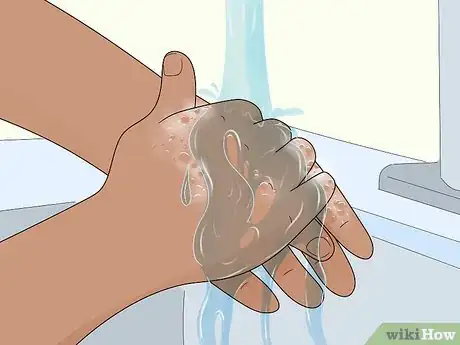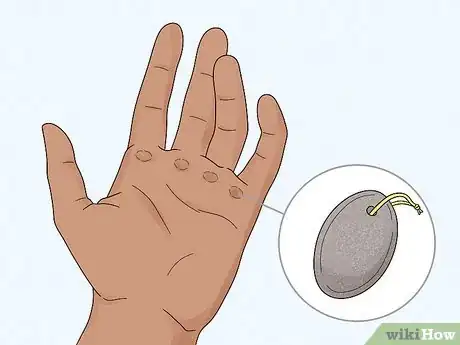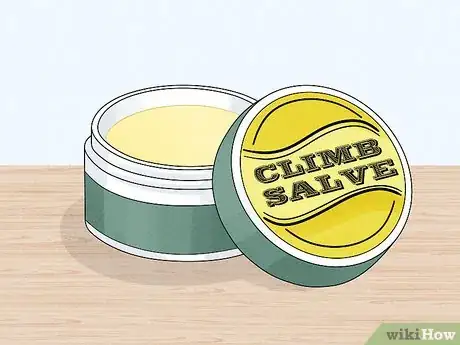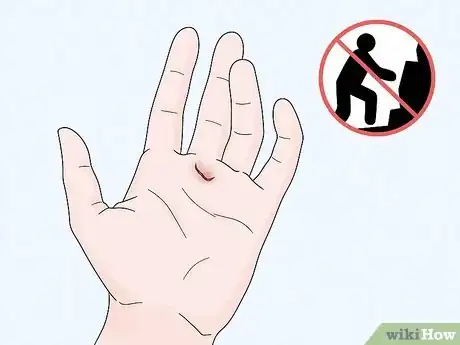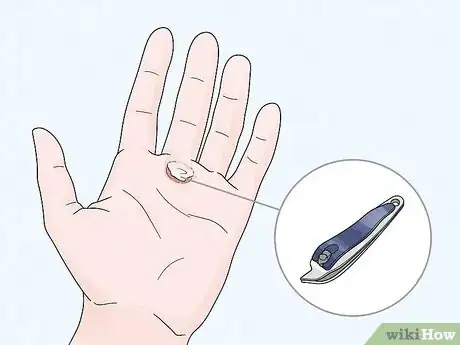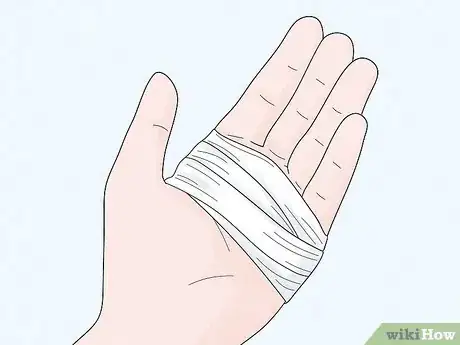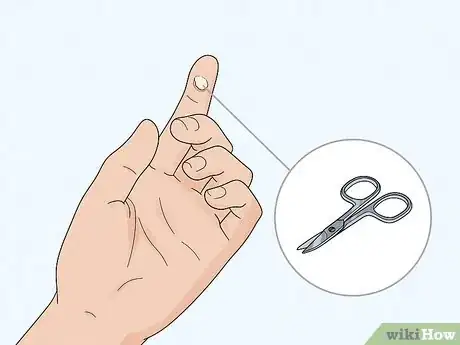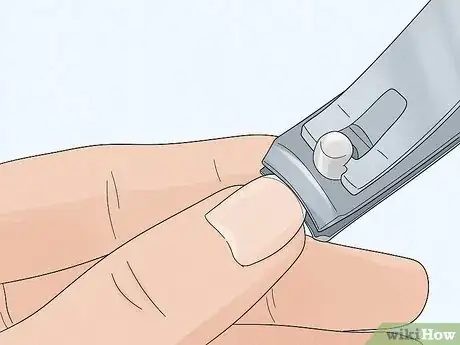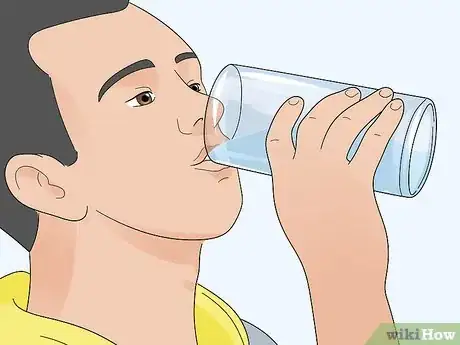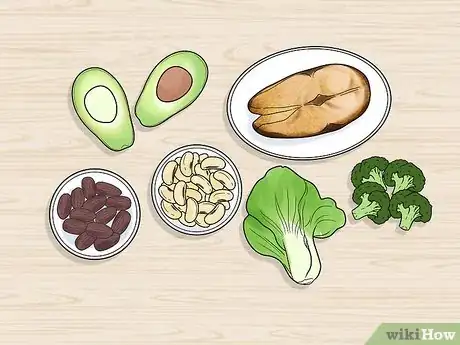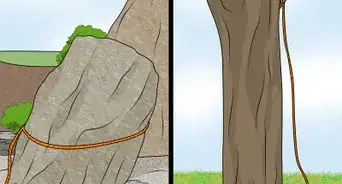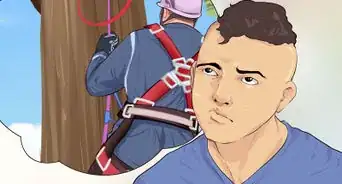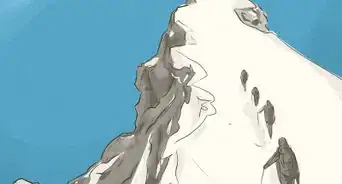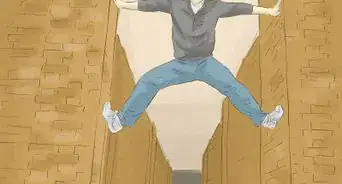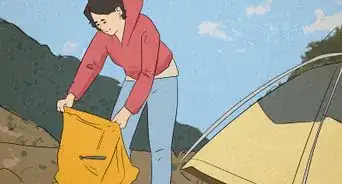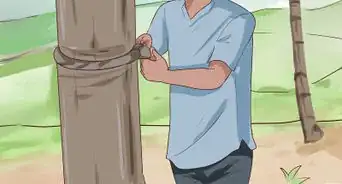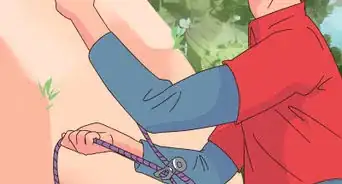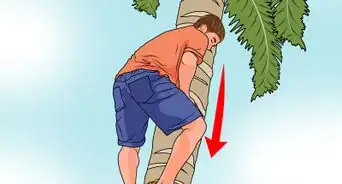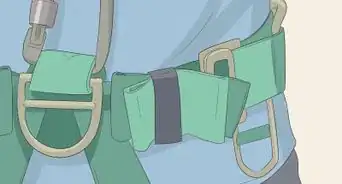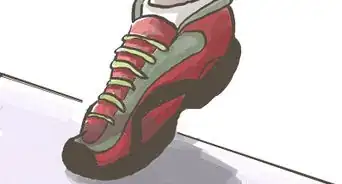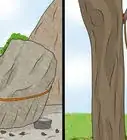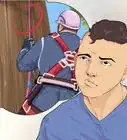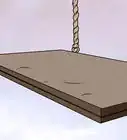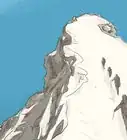This article was co-authored by wikiHow Staff. Our trained team of editors and researchers validate articles for accuracy and comprehensiveness. wikiHow's Content Management Team carefully monitors the work from our editorial staff to ensure that each article is backed by trusted research and meets our high quality standards.
This article has been viewed 14,325 times.
Learn more...
Rock climbing is a fun activity for everyone, but it can be tough on your hands. Even a light session could cause raw skin and sore muscles. Luckily, healing your hands after climbing only requires some simple skincare tips, and treating wounds is easy with basic first-aid. If your hands are chapped or sore from your last climbing session, with the right care, you can be back to climbing in no time!
Steps
Treating Soreness and Calluses
-
1Wash your hands as soon as you’re done climbing. All the chalk and gunk on your hands from climbing will dry your skin out and could cause infections. As soon as possible after climbing, wash your hands thoroughly with gentle soap and warm water. Then dry them with a clean towel.[1]
- You'll pick up a lot of bacteria while you're climbing, and the residue on your hands could trap that bacteria. That's why washing your hands is so important.
- It’s also a good idea to wash your hands before climbing to avoid spreading any germs to other climbers. Be courteous and wash up before hitting the rock wall.
-
2File down your calluses so they’re smooth and flat. Most climbers will build up calluses pretty quickly, which is a good thing. However, calluses that stick out could get caught on the rock and tear, leading to a serious injury. After every climbing session, take a look at your hands and find any calluses protruding outwards. Use a pumice stone or file and grind the callus down so it’s flat. This prevents injuries later on.[2]
- Remember that you don’t want to remove calluses completely, because you need them to protect your hands. Only file your hands enough so the calluses are flat and won’t get caught on anything.
- You can file your calluses while your hands are wet or dry. Try each method to see which one you like best.
Advertisement -
3Apply climbing salve to your fingertips to moisturize your skin. Keeping your skin moisturized helps prevent cracks and cuts. As soon as you’re done washing up and filing after a climbing session, rub some salve onto rough spots and calluses on your hands to help them heal. Then cover the spots with climbing tape so you don’t get the salve all over the place. Wrap the tape loosely so it doesn't cut off the circulation in your fingers. Repeat this treatment for a few days after climbing to treat raw or sore skin.[3]
- You can get climbing salve from sporting goods or outdoor stores. Feel free to ask an employee for a recommendation.
- Plain moisturizing lotion could work too, but this might prevent calluses from forming. Since calluses protect your hands, you’ll actually want them to form if you plan on climbing often.
- Don’t use salve before climbing or you could slip off the rocks.[4]
-
4Soak your hands in ice water after climbing to treat soreness. It’s only natural that your skin and muscles will be a little sore after a climbing session. A good home remedy for this is a cold soak. Put some water and ice cubes into a bowl and submerge your hands for a few minutes. This helps soothe the pain and encourages your muscles to heal.[5]
- You could also use a cold compress or ice pack for a similar treatment.
-
5Stretch out your fingers and hands to encourage your muscles to heal. Your muscles will be tight and sore after a climbing session, and some simple stretches can help. Open and close your hands a few times to loosen up. Then try flexing your fingers as much as you can to stretch out your hands. Also stretch your forearms by pushing your hands back and forth. These stretches can soothe tense muscles and help them heal better.[6]
- Massaging your hands and forearms after climbing can help too. It might not heal your hands, but it’ll definitely feel good.
- It’s also good to do these same stretches to warm up before climbing. This can prevent soreness later on.
Taking Care of Cuts and Flappers
-
1Stop climbing if you get a cut or crack in your hand. Any cut while you’re climbing is potentially serious, so don’t try to climb with open wounds. Keep an eye on your hands while you’re climbing. If you see any cuts or cracks, or feel any sharp pains, stop to take care of that right away.[7]
- Stopping to treat a wound is especially important if you’re bleeding. Other climbers don’t want to touch your blood, so be sure to take care of your cuts as soon as possible.
-
2Wash the cut as well as you can. Depending on where you are, this might be easy or hard. If you’re near a bathroom, then go wash the cut with soap and water. If you’re out in the middle of nowhere, then rinse the wound with some water from your bottle if you have it. Do your best to get any dirt out of the wound.[8]
- Don’t rinse your hand with dirty water. This could cause a serious infection.
-
3Trim the loose skin away from a flapper. A flapper is a nasty injury that happens when a piece of your skin gets caught on the rock and peels back to make a flap—hence the name. The best way to treat a flapper is trimming the loose skin back. Use a clean nail cuticle scissor and trim the flap as far back as you can by cutting off the dead skin. Then wash the wound again to prevent infections.[9]
- Make sure the scissors are clean or you could get a bad infection.
- This will definitely be painful, so don’t try it if it’s too much for you. Go to the doctor instead.
- If you don’t have the stomach to trim your skin away, then you can also tape it back down. Cover the injury with a bandage, then wrap climbing tape around it to keep the skin down. Make sure the tape isn't tight enough to cut off circulation in your finger.
-
4Cover the wound with a bandage and tape. Whether or not you plan to continue climbing, you need to cover the wound to prevent infections. Wrap the wound with a bandage and make sure it’s covered. If you’re going to keep climbing, then wrap tape around the bandage to stop it from slipping off.[10]
- If you want to keep climbing, then bandages might be slippery. Some climbers prefer a liquid bandage or glue instead.
- If the wound is big and blood soaks through the bandage, then you probably need stitches. Stop climbing and get medical attention.
-
5Rest your hands until the skin heals. Flappers, cuts, or cracks take some time to heal, and they’ll only get worse if you keep climbing. It’s best to take a break and give the wound at least a few days to heal. You can hit the rocks again when you’re healed up.[11]
- Flappers are pretty nasty, but they can usually heal up within a week. Deeper cracks, however, can take a long time to heal.
- Some climbers try to push through injuries if their trip is short. In this case, make sure you keep the wound covered and wrap the bandage with plenty of tape to keep it in place.
Preventing Climbing Injuries
-
1Trim or cover any skin flaps before climbing. Any tags or flaps of skin could get caught on the rocks and give you a painful flapper. Some climbers use nail scissors to clip off any skin tags before climbing. If this doesn’t sound appealing to you, you could cover yours with climbing tape so they don’t get caught on anything.[12]
- If you do clip off any skin flaps, make sure the scissors are clean and disinfected. Don’t clip back so far that you bleed.
-
2Keep your nails short. Long nails can get caught on rocks and tear, so always make sure your nails are short before climbing. Cut them back so there are no white tips to avoid catching them on the rocks.[13]
- If you keep a scissor or nail clippers in your climbing bag, you can easily trim off any hangnails that you notice while you’re climbing.
-
3Stay hydrated to keep your skin moisturized. Your skin is more vulnerable to cracks and tears when you’re dehydrated, so make sure you stay hydrated for your entire session. Drink plenty of water and take breaks if you have to.[14]
- In general, you should drink enough so your urine is light yellow and you don’t feel thirsty. Dark urine is an early sign of dehydration.
-
4Eat plenty of omega-3s in your daily diet. Omega-3s are responsible for fighting inflammation and hydrating your skin. A diet rich in these nutrients could you’re your skin stronger and more resistant to climbing injuries.[15] Eat plenty of fish, nuts, seeds, and vegetable oils to get your daily omega-3 dose.[16]
- You can also take fish oil or seaweed supplements if you aren’t getting enough omega-3s from your normal diet.
Warnings
- If you have a large wound that won’t stop bleeding, then stop climbing right away. You need medical attention for these kinds of injuries. It's also unsanitary to keep climbing because you could expose other climbers to your blood.⧼thumbs_response⧽
References
- ↑ https://rockclimbingcentral.com/10-ways-to-treat-your-sore-hands-caused-by-rock-climbing/
- ↑ https://sendedition.com/how-do-you-deal-with-climbing-flappers/
- ↑ https://www.climbing.com/skills/ultimate-skin-care-handbook/
- ↑ https://www.climbing.com/skills/ultimate-skin-care-handbook/
- ↑ https://rockclimbingcentral.com/10-ways-to-treat-your-sore-hands-caused-by-rock-climbing/
- ↑ https://rockclimbingcentral.com/10-ways-to-treat-your-sore-hands-caused-by-rock-climbing/
- ↑ https://rockandice.com/climbing-gear-tips/climbing-skin-care/?cn-reloaded=1
- ↑ https://rockclimbingcentral.com/10-ways-to-treat-your-sore-hands-caused-by-rock-climbing/#Bleed
- ↑ https://www.climbing.com/skills/ultimate-skin-care-handbook/
- ↑ https://rockclimbingcentral.com/10-ways-to-treat-your-sore-hands-caused-by-rock-climbing/
- ↑ https://www.climbing.com/skills/ultimate-skin-care-handbook/
- ↑ https://rockclimbingcentral.com/10-ways-to-treat-your-sore-hands-caused-by-rock-climbing/
- ↑ https://www.climbing.com/skills/ultimate-skin-care-handbook/
- ↑ https://rockclimbingcentral.com/10-ways-to-treat-your-sore-hands-caused-by-rock-climbing/
- ↑ https://www.climbing.com/skills/ultimate-skin-care-handbook/
- ↑ https://ods.od.nih.gov/factsheets/Omega3FattyAcids-Consumer/
